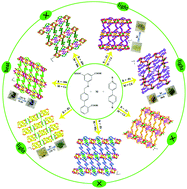A series of host–guest coordination polymers containing viologens: syntheses, crystal structures, thermo/photochromism and factors influencing their thermo/photochromic behaviors†
Abstract
Responsive molecular chromic materials have shown potential applications in molecular optical switches and sensor devices as they undergo reversible colour changes upon application of external stimuli. Herein, six host–guest coordination polymers 1–6 and one organic supramolecular compound 7 containing viologens have been synthesized under hydrothermal conditions. Compound 1 shows thermochromic behavior with a colour change from green to blue upon heating at 150 °C in air. Compounds 3, 4 and 7 display photochromic behaviors with a colour change from pale yellow to green under UV light, visible light or sunlight. The relationship between their structures and chromic behaviors has been discussed. Thermo/photochromic mechanisms have been investigated by infrared spectroscopy, powder X-ray diffraction analysis, UV-vis absorption spectroscopy, electron paramagnetic resonance spectroscopy, and X-ray photoelectron spectroscopy. The results demonstrate the generation of viologen radicals caused by thermo/photo-induced electron transfer. It is found that compound 4 can be used as an inkless and erasable printing medium. In addition, compounds 3, 4, and 7 can be used as anti-counterfeiting materials for QR codes. Our findings demonstrate the possibility of applying thermo/photochromic coordination polymers in molecular devices.



 Please wait while we load your content...
Please wait while we load your content...